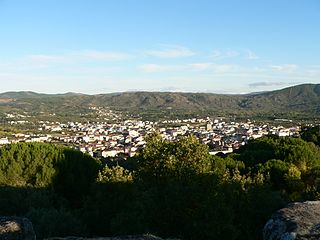
Verín is a town and municipality in the southeast of the province of Ourense, in the autonomous community of Galicia, Spain. The population of the municipality is about 14,433. It is located 70 kilometers east of the provincial capital of Ourense and 15 kilometers north of the Portuguese city of Chaves. The Tâmega River flows through the town. In the Middle Ages it was known as Santa María de Verín.

Ourense is a city and the capital of the province of Ourense, located in the autonomous community of Galicia, northwestern Spain. It is on the Camino Sanabrés path of the Way of St James, and is crossed by the Miño, Barbaña, Loña and Barbañica rivers. It is also known as A cidade das Burgas due to its hot springs, being one of the European cities with the greatest thermal heritage.

Allariz is a town and municipality in the province of Ourense, in the autonomous community of Galicia, Spain. It occupies the center of the western half of the province, connecting with the towns (concellos) of Taboadela, Paderne, Sandiás, Vilar de Santos, Rairiz de Veiga, Xunqueira de Ambía, A Merca and A Bola. The area of the municipality is 85,3 km² and there are 6.188 inhabitants in 16 parishes.

Boimorto is a municipality in the province of A Coruña, in the autonomous community of Galicia, northwestern Spain. It is located in the comarca of Arzúa. It has an area of 82.71 km2, a population of 2,486, and a population density of 30.06 people/km2. Coordinates: 43° 00' 27" N - 8° 07' 37" W. Elevation: 487 m.

Galicians are a European ethnic group from northwestern Spain; it is closely related to the northern Portuguese people and has its historic homeland in Galicia, in the north-west of the Iberian Peninsula. Two Romance languages are widely spoken and official in Galicia: the native Galician and Spanish.
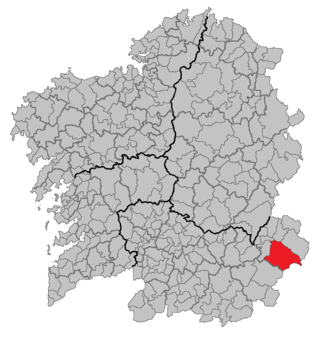
A Veiga is a municipality (concello) in the south-east of the province of Ourense in the autonomous community of Galicia, Spain. At 291 km², it is one of the largest concellos in the province. The capital is the town of A Veiga, also known as A Veiga or Santa María da Veiga to distinguish it from other towns and villages in Galicia of the same name. A Veíga is located 150 km from Ourense. The municipality has a population of 1,273 (2005), and a relatively low and decreasing population density.
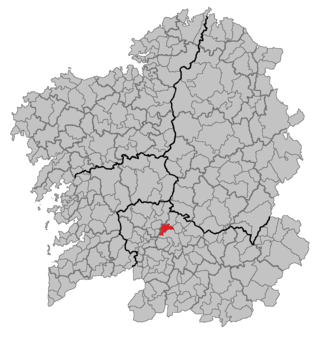
Amoeiro is a municipality in the province of Ourense, in the autonomous community of Galicia, Spain. It belongs to the comarca of Ourense. It connects borders the municipalities of San Cristovo de Cea, Vilamarín, Coles, Ourense, Punxín and Maside. In 2016, it had a population of 2264 inhabitants.

Quintela de Leirado is a municipality in the province of Ourense, in the autonomous community of Galicia, Spain. It belongs to the comarca of Terra de Celanova.
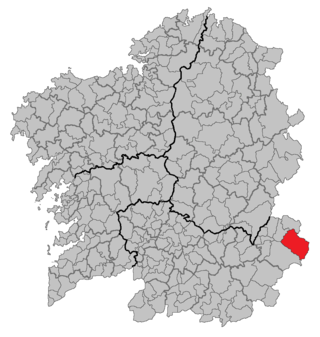
Carballeda de Valdeorras is a large municipality in the province of Ourense, in the autonomous community of Galicia, Spain. It belongs to the comarca of Valdeorras.
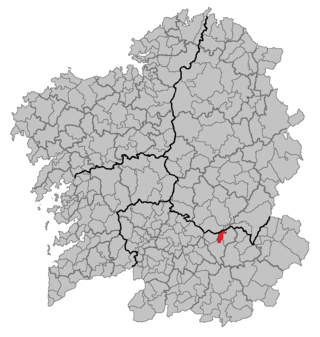
A Teixeira is a municipality in the province of Ourense, in the autonomous community of Galicia, Spain. It belongs to the comarca of Terra de Caldelas. In 2008, it had a population of 505.
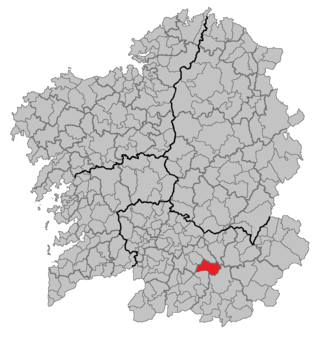
Vilar de Barrio is a municipality in the centre of the province of Ourense, in the autonomous community of Galicia, Spain. It belongs to the comarca of A Limia.
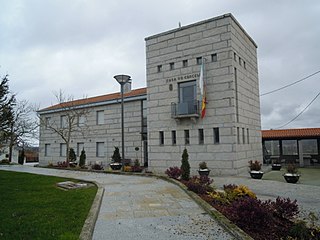
Calvos de Randín is a municipality in the province of Ourense, in the autonomous community of Galicia in northwestern Spain. It is located in one of the southernmost points of Galicia, bordering Portugal to the south.

Avión is a municipality in the province of Ourense, in the autonomous community of Galicia, Spain. It belongs to the comarca of O Ribeiro. It has a population of 1,910 (2016) and an area of 121 km².

Riós is a municipality in the province of Ourense, in the autonomous community of Galicia, Spain. It belongs to the comarca of Verín. It has a population of 2032 and an area of 114 km².
Bandua was a theonym used to refer to a god or goddess worshipped in Iberia by Gallaeci and Lusitanians. Whether the name referred to a discrete deity or was an epithet applied to different deities is arguable.
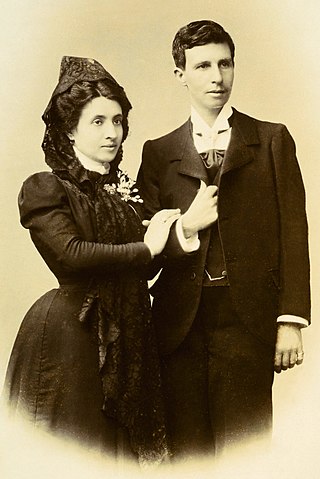
The first same-sex marriage in Spain occurred on 8 June 1901. Two women, Marcela Gracia Ibeas and Elisa Sánchez Loriga, attempted to get married in A Coruña. To achieve it Elisa had to adopt a male identity: Mario Sánchez, as listed on the marriage certificate. It is the first attempt at same-sex marriage in Spain for which there is recorded evidence. It was performed by the Church, in the parish church of Saint George of the same city. The marriage certificate was never annulled.
This is a list of notable events in the history of lesbian, gay, bisexual and transgender (LGBT) rights that took place in Spain.
Communist Movement of Galicia was a communist political party created in Galicia during the last years of the dictatorship of Franco as the Galician section of the Communist Movement, although in practice the MCG acted as an independent party. The leaders of the MCG were Xesús Veiga Buxán and Carmen Santos Castroviejo. Unlike other sections of Spanish left-wing political parties, the MCG was close to the Galician nationalist movement and supported self-determination and national sovereignty for Galicia.
The Perdigueiro Galego is a rare breed of pointer from the autonomous community of Galicia in north-western Spain. It is one of four traditional breeds of the region, the others being the Can de Palleiro, the Guicho or Quisquelo, and the Podengo Galego.
Gabriel Veiga Novas is a Spanish professional footballer who plays as a central midfielder for Saudi Pro League club Al-Ahli.

















